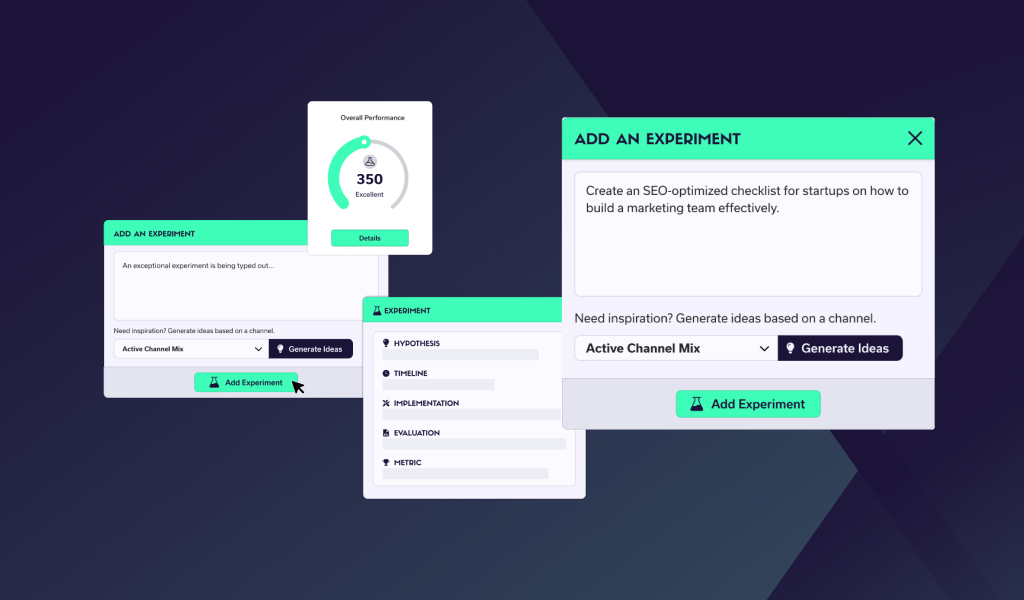A common problem we find among companies experimenting with growth marketing is a lack of structure. They haphazardly test ideas, hypotheses and channels, but due to the lack of structure they don’t have an efficient way to analyse results and sometimes are not even sure what results they want to get.
In this article we’ll explain how to create a growth marketing framework to keep your growth efforts on track.
What is a growth marketing framework?
A growth marketing framework is a set of rules and practices that will ensure your growth experiments have clear intentions, are measured correctly and analysed accurately. It is a process for identifying problems or opportunities, testing solutions or ideas, and learning the right lessons from those tests. If you follow the process consistently your growth marketing efforts will be much more successful and much more efficient.
The framework will be unique to each sector and even to each business. This article will show you how to create your own growth marketing framework that is uniquely applicable to your situation.
How to create a growth marketing framework
1 - Define & measure your marketing funnel
It’s very common for companies to not know what their marketing funnel looks like. They might have a generalised version (awareness, consideration, conversion, advocacy) but they haven’t built one specific to them. They don’t know what stages their customers go through when interacting with the product, let alone measure what proportion of customers go through those stages.
The reason to do this is because it can show you where your weaknesses and opportunities are. By going through the process of defining and measuring your marketing funnel you may spot that you have an unusually low conversion %, or an unusually low advocacy rate.
There are two steps to getting the information you need to do this
- Qualitative: talk to your customers to see what stages they go through.
- Quantitative: use the data your company collects to analyse the numbers of customers passing through each step.
By doing this, you’ll put yourself in a great position to pick the right goals to help your business grow.
2- Define Your Objectives And Key Results (OKRs)
It seems obvious, but to reach your goals you need to be clear about what they are. Once you’ve got your funnel fleshed out you should be able to see a picture of what you need to improve.
OKRs are a way of defining your goals that makes them practical, achievable and measurable. OKRs are goals that an individual or a team can be held accountable to. They’re not just plucked out of thin air, they’re based on data and market understanding.
Apologies for introducing another acronym - but it really helps to make these objectives SMART (specific, measurable, achievable, relevant and timebound). As an example, a SMART objective would not be ‘we want to delight our customers’. It would be: ‘we want to increase the lifetime value of our customers by 10% within 12 months’.
To turn that objective into an OKR, you’d then add key results that plot the way to the endpoint. For example: reduce churn by x%, or raise the average initial order value by Y%. Ideally you’d have around 3 key results per objective, and these key results should be clear measurable milestones that will help you achieve the objective.
3- Brainstorm ideas
Once you’ve defined your OKRs, assemble your team and brainstorm ideas to hit them. There’s obviously not a huge amount to this, but here are some key pointers:
- Everyone needs to be encouraged to contribute. A contribution doesn’t necessarily need to be an idea - it could be a pertinent question that reveals the flaw in someone else’s idea.
- Everyone needs to be able to separate themselves from their idea. Often when someone contributes an idea to a project, they see that idea as an extension of themselves. That can lead to feeling personally attacked if someone critiques an idea, or like they’ve failed if their idea doesn’t get carried forward. It’s difficult to do, because this is a human nature problem, but ideally everyone should buy into the concept that once an idea is out there, it is its own entity - it’s not tied to whoever said it outloud.
- All ideas need to be recorded in a master ideas document. It’s worth recording every single one because they may not be right for the moment, but they may be right further down the line. Do this in your preferred project management software or a spreadsheet.
4 - Prioritise
Once you have brainstormed ideas, you then need to prioritise a few to test. The number of ideas to test will vary depending on your OKRs and resources but it’s better to test a few ideas thoroughly than try to test too many ideas. Just one or two per OKR is a good starting point.
Next to every idea you have written down you should put the following criteria, scored out of 10:
A) The potential impact of the idea. If it works, how much could it move the needle?
B) The estimated chance of success.
C) The resources needed to properly test the idea.
Often these will be in conflict. Sometimes an idea that has the potential to be hugely impactful will have a low chance of success, or will need a lot of resources to test. In that case I’m afraid you’re just going to have to make a judgement call.
5- Turn your ideas into experiments
Now you should create a document that turns the chosen ideas into experiments.
For each idea you have chosen you should create an experiment document that includes the following:
- Objective - what objective and/or key results is this idea attempting to influence?
- Hypothesis - what impact do you expect the idea will have on the above objective and/or key result?
- Measurables - what will be the key performance indicators of this idea? These should be simple measurable metrics Eg. Click through rate, bounce rate, session duration.
- Timeframe - how long will you run the experiment for? Don’t be tempted to make this too short. Some experiments can take a while to bear fruit. Generally, we recommend running them for at least 30 days.
- Experiment owner - who is responsible for managing the implementation of the experiment and gathering results?
- Results - create a table where you will enter results. These should be pre-populated with what the measurables currently are, so you can easily track improvements or regressions. Watch out for false negatives in your campaigns - we see this time and time again and it can wreck havoc on your results.
6- Run the experiment & analyse results
Now you’re ready to deploy your experiment and gather data.
In analysing the results you need to consider the following:
- What was the impact of the experiment? Did you achieve the expected results?
- Why did the experiment have the results it did?
- How accurate were your predictions? Not just in terms of results - did you correctly estimate the business resources required to run the experiment?
All of this should be recorded in your master ideas document and in each experiment document.
7- Refine the process
Now it’s time to look again at the process itself.
How well do you think you did through each stage of the growth marketing framework? What went wrong and what went right? How can you make improvements that will ensure future experiments have a greater chance of success and a greater impact?
Once you’ve been through this process you’ll be armed with a set of documents and protocols. These make up your growth framework. Over time, as you run through the process again and again, it will become more efficient and more refined, and as a result you’ll see more success out of your growth experiments.
Talk to a Growth Advisor
We create a clear, focused marketing strategy by combining our expertise with your knowledge of your business.
Trusted by over 130 startups because our unique growth process and team of marketing experts unlock exponential growth











